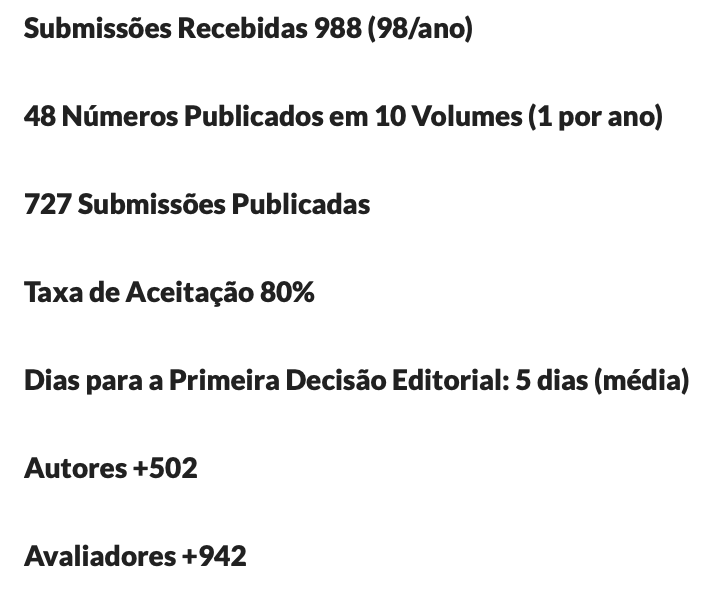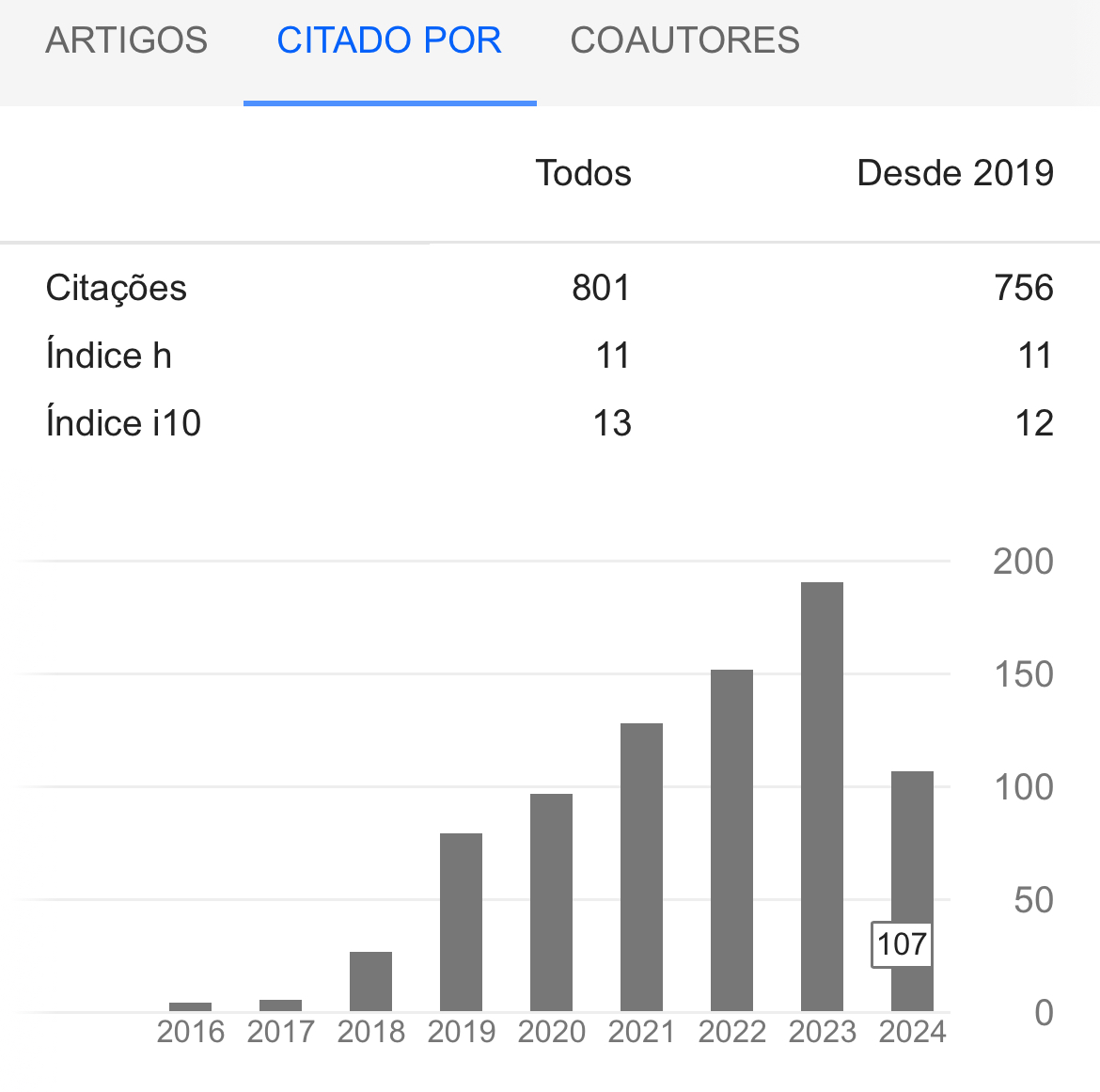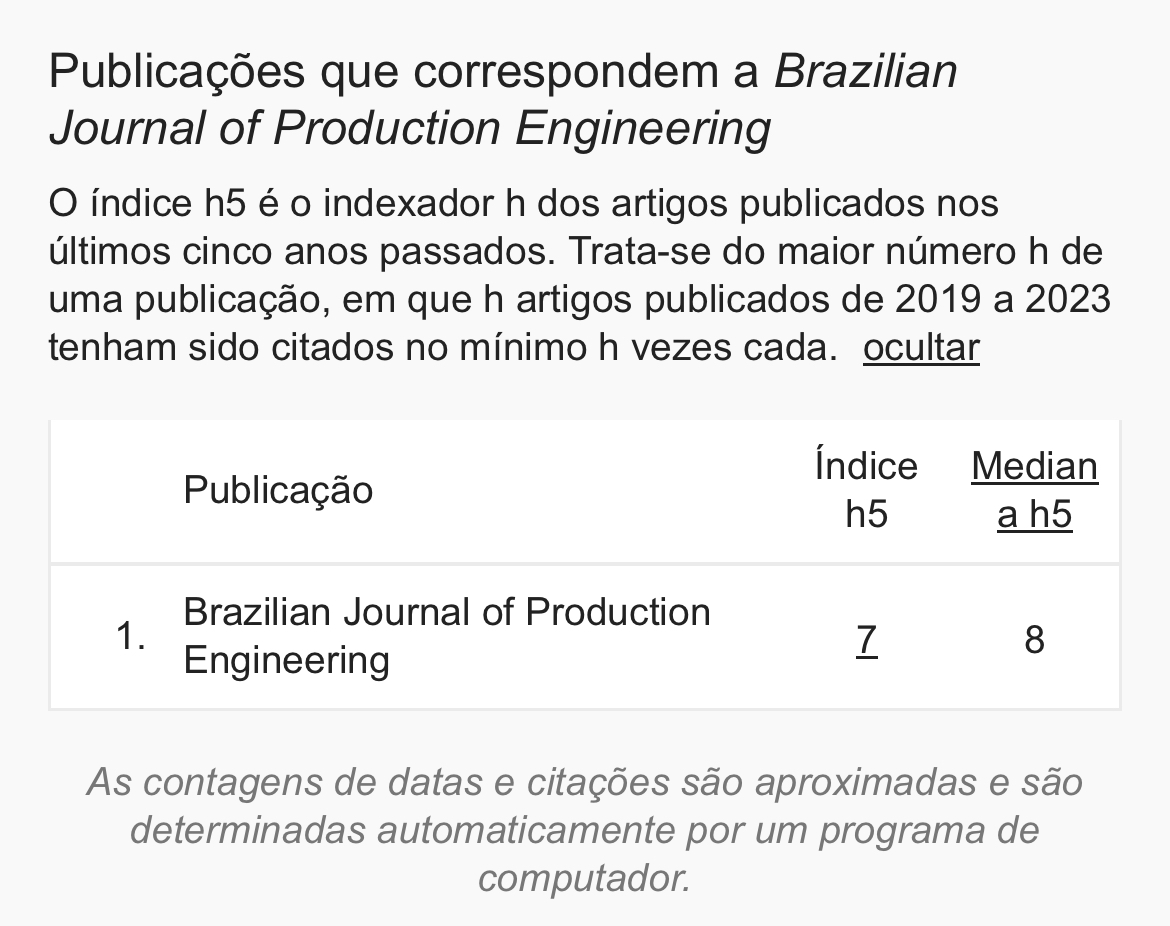MAPPING AND ANALYSIS OF SCIENTIFIC PRODUCTION ON ROAD SAFETY
MAPPING AND ANALYSIS OF SCIENTIFIC PRODUCTION ON ROAD SAFETY
Keywords:
Traffic Safety; Road safety; Bibliometry; Analyze; Strategy.Abstract
Bibliometric analysis is an important tool for visualizing knowledge on topics of interest relevant to society. In this article, we use this resource with the main objective of mapping and analyzing the knowledge produced on a topic of global relevance: traffic safety. In this sense, we conducted a search for articles published on the topic in the Scopus database, starting in 2011, considering the “Decade of Action for Traffic Safety 2011-2020”. 7,956 articles written in English were retrieved, from which the main countries, authors, sources, institutions and areas that addressed the topic of road safety were presented. Then, according to refining criteria, 26 articles were selected for the content analysis stage. This step was aided by the VOSviewer Software that contributed to the visualization of elements that were discussed. The results showed a preponderance of studies on human behavior in traffic, mainly violations due to excessive speed and alcohol consumption by drivers, in addition to the concern with pedestrian safety. There was a tendency towards a systemic approach to traffic safety, in order to consider multiple factors involved in this context, and not only the human factor. Therefore, the traditional 3E's strategy of traffic safety has been expanded, with the inclusion of other E's, in order to enable the formulation of more effective strategies and appropriate to the experienced scenario.
Downloads
References
Adanu, E. K., Penmetsa, P., Jones, S., & Smith, R. (2018). Gendered Analysis of Fatal Crashes among Young Drivers in Alabama, USA. Safety, 4(3), 29.
Aria, M., & Cuccurullo, C. (2017). bibliometrix: An R-tool for comprehensive science mapping analysis. Journal of Informetrics, 11(4), 959–975.
Assailly, J. P. (2017). Road safety education: What Works? Patient Education and Counseling, 100, S24-S29.
Atombo, C., Wu, C., Zhong, M., & Zhang, H. (2016). Investigating the motivational factors influencing drivers intentions to unsafe driving behaviours: speeding and overtaking violations. Transportation Research Part F: Traffic Psychology and Behaviour, 43, 104-121.
D'Amato, D., Droste, N., Allen, B., Kettunen, M., Lähtinen, K., Korhonen, J., Leskinen, P., Matthies, B. D., Toppinen, A. (2017). Green, circular, bio economy: acomparative analysis of sustainability avenues. Journal of Cleaner Production, 168, 716-734.
Danaf, M., Hamdar, S. H., Abou-Zeid, M., & Kaysi, I. (2018). Comparative assessment of driving behavior at signalized intersections using driving simulators. Journal of Transportation Safety & Security, 10, 124-158.
Dean, J., Wray, A. J., Braun, L., Casello, J. M., McCallum, L., & Gower, S. (2019). Holding the keys to health? A scoping study of the population health impacts of automated vehicles. BMC Public Health, 19, 1258.
Fleiter, J. J., Watson, B. (2016). Addressing the road trauma burden in China: Exploring attitudes, behaviours, risk perceptions and cultural uniqueness. Accident Analysis & Prevention, 95, 326-333.
Gumus, S., Bellibas, M. S., Esen, M., & Gumus, E. (2018). A systematic review of studies on leadership models in educational research from 1980 to 2014. Educational Management Administration & Leadership, 46(1), 25-48.
Gururaj, G. (2014). Growing burden and impact of road crashes in India: Need for a safe systems approach. International Journal of Vehicle Safety, 7(3-4), 282-295.
Heradio, R., de la Torre, L., Galán, D., Cabrerizo, F. J., Herrera-Viedma, E., Dormido, S. (2016). Virtual and remote labs in education: A bibliometric analysis. Computers & Education, 98, 14–38.
Hughes, B. P., Anund, A., & Falkmer, T. (2016). A comprehensive conceptual framework for road safety strategies. Accident Analysis & Prevention, 90, 13-28.
Islam, M. T., & El-Basyouny, K. (2013). An integrated speed management plan to reduce vehicle speeds in residential areas: implementation and evaluation of the Silverberry Action Plan. Journal of Safety Research, 45, 85-93.
Jamal, A., Rahman, M. T., Al-Ahmadi, H. M., & Mansoor, U. (2019). The Dilemma of Road Safety in the Eastern Province of Saudi Arabia: Consequences and Prevention Strategies. International Journal of Environmental Research and Public Health, 17(1), 157.
Kim, E., Muennig, P., & Rosen, Z. (2017). Vision zero: a toolkit for road safety in the modern era. Injury epidemiology, 4(1), 1.
Kitamura, Y., Hayashi, M., & Yagi, E. (2018). Traffic problems in Southeast Asia featuring the case of Cambodia's traffic accidents involving motorcycles. IATSS Research, 42(4), 163-170.
La, Q. N., Van Duong, D. V., Lee, A. H., Meuleners, L. B. (2017). Factors underlying bus-related crashes in Hanoi, Vietnam. Transportation Research Part F: Traffic Psychology and Behaviour, 46, 426-437.
Lamiani, G., Borghi, L., & Argentero, P. (2017). When healthcare professionals cannot do the right thing: A systematic review of moral distress and its correlates. Journal of health psychology, 22(1), 51–67.
Liao, H., Tang, M., Luo, L., Li, C., Chiclana, F., & Zeng, X.-J. (2018). A Bibliometric Analysis and Visualization of Medical Big Data Research. Sustainability, 10(2), 166.
Marshall, W. E. (2018). Understanding international road safety disparities: Why is Australia so much safer than the United States?. Accident Analysis & Prevention, 111, 251-265.
McIlroy, R. C., Plant, K. A., Hoque, M. S., Wu, J., Kokwaro, G. O, Nam, V. H., & Stanton, N. A. (2019). Who is responsible for global road safety? A cross-cultural comparison of Actor Maps. Accident Analysis & Prevention, 122, 8-18.
Merediz-Solà, I., & Bariviera, A. F. (2019). A bibliometric analysis of bitcoin scientific production. Research in International Business and Finance, 50, 294-305.
Merigó, J. M., Gil-Lafuente, A. M., & Yager, R. R. (2015). An overview of fuzzy research with bibliometric indicators. Applied Soft Computing, 27, 420-433.
Mohan, D., Bangdiwala, S. I., Villaveces, A. (2017). Urban street structure and traffic safety. Journal of Safety Research, 62, 63-71.
Peiris, S., Berecki-Gisolf, J., Chen, B., & Fildes, B. (2020). Road Trauma in Regional and Remote Australia and New Zealand in Preparedness for ADAS Technologies and Autonomous Vehicles. Sustainability, 12(11), 4347.
Pollack, K. M., Gielen, A. C., Ismail, M. N. M., Mitzner, M., Wu, M., & Links, J. M. (2014). Investigating and improving pedestrian safety in an urban environment. Injury epidemiology, 1(1), 11.
Poswayo, A., Kalolo, S., Rabonovitz, K., Witte, J., & Guerrero, A. (2019). School Area Road Safety Assessment and Improvements (SARSAI) programme reduces road traffic injuries among children in Tanzania. Injury Prevention, 25(5), 414-420.
Rahman, M. L., Moore, A., Smith, M., Lieswyn, J., & Mandic, S. (2020). A Conceptual Framework for Modelling Safe Walking and Cycling Routes to High Schools. International Journal of Environmental Research and Public Health, 17(9), 3318.
Riaz, M. S., Cuenen, A., Dhondt, S., Craps, H., Janssens, D., Wets, G., Brijs, T., & Brijs, K. (2019). Evaluation of a Road Safety Education Program Based on Driving Under Influence and Traffic Risks for Higher Secondary School Students in Belgium. Safety, 5(2), 1-18.
Safarpour, H., Khorasani-Zavareh, D., & Mohammadi, R. (2020). The common road safety approaches: A scoping review and thematic analysis. Chinese journal of traumatology, 23(2), 113-121.
Salmon, P. M., Read, G. J. M., Thompson, J., McLean, S., & McClure, R. (2020). Computational modelling and systems ergonomics: a system dynamics model of drink driving-related trauma prevention. Ergonomics, 63(8), 965-980.
Smiley, A., & Rudin-Brown, C. (2020). Drivers adapt – Be prepared for It!, Accident Analysis & Prevention, 135, 105370.
Soathong, A., Wilson, D., Ranjitkar, P., & Chowdhury, S. (2019). A Critical Review of Policies on Pedestrian Safety and a Case Study of New Zealand. Sustainability, 11(19), 5274.
Tay, R., De Barros, A. (2011). Should traffic enforcement be unpredictable? the case of red light cameras in Edmonton. Accident Analysis & Prevention, 43(3), 955-961.
Tetali, S., Lakshmi, J. K., Gupta, S., Gururaj, G., Wadhwaniya, S., & Hyder, A. A. (2013). Qualitative study to explore stakeholder perceptions related to road safety in Hyderabad, India. Injury, 44(SUPPL. 4), S17-S23.
Toroyan, T., Khayesi, M., & Peden, M. (2013). Time to prioritise safe walking. International Journal of Injury Control and Safety Promotion, 20(2), 197-202.
Van der Have, R. P., & Rubalcaba, L. (2016). Social innovation research: An emerging area of innovation studies?. Research Policy, 45(9), 1923–1935.
Waltman, L. (2016). A review of the literature on citation impact indicators. Journal of Informetrics, 10(2), 365-391.
Wang, B., & Wu, C. (2019). Using an evidence-based safety approach to develop China's road safety strategies. Journal of global health, 9(2), 020602.
Wegman, F. (2017). The future of road safety: A worldwide perspective. IATSS Research, 40(2), 66-71.
World Health Organization - WHO. (2015). Global status report on road safety 2015. Genebra: Organização Mundial de Saúde. Recuperado em 02 de março de 2020, de https://www.who.int/violence_injury_prevention/road_safety_status/2015/status_report2015/en/.
World Health Organization - WHO. (2017). Global Plan for the Decade of Action for Road Safety 2011-2020. Genebra: Organização Mundial de Saúde. Recuperado em 25 de julho de 2020, de https://www.who.int/roadsafety/decade_of_action/plan/en/.
World Health Organization - WHO. (2018). Global status report on road safety 2018. Genebra: Organização Mundial de Saúde. Recuperado em 16 de outubro de 2019, de https://www.who.int/publications-detail/global-status-report-on-road-safety-2018.
Zhang, G., Fan, Y., Jiang, X., Fan, W., Meng, T., & Xu, M. (2019). Assessing the impacts of signal coordination on the crash risks of various driving cohorts. Journal of Safety Research, 70, 79-87.
Zhang, G., Yau, K. K. W., Zhang, X. (2014). Analyzing fault and severity in pedestrian-motor vehicle accidents in China. Accident Analysis & Prevention, 73, 141-150.
Zou, X., & Vu, H. L. (2019). Mapping the knowledge domain of road safety studies: A scientometric analysis. Accident Analysis & Prevention, 132, 105243.
Zou, X., Yue, W. L., & Vu, H. L. (2018). Visualization and analysis of mapping knowledge domain of road safety studies. Accident Analysis & Prevention, 118, 131–145.
Zupic, I., & Čater, T. (2015). Bibliometric Methods in Management and Organization. Organizational Research Methods, 18(3), 429-472.
Downloads
Published
How to Cite
Issue
Section
License
Copyright (c) 2020 Brazilian Journal of Production Engineering - BJPE

This work is licensed under a Creative Commons Attribution-NonCommercial-ShareAlike 4.0 International License.











































































